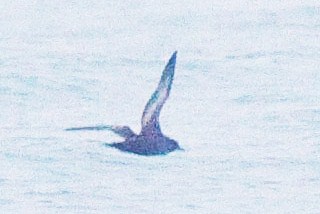Separation of Sooty and Short-tailed Shearwaters, especially lone birds out of their regular range is notoriously difficult. A couple of useful on-line references seem to be:
www.aba.org/birding/v40n2p34.pdf
and
http://thebirdguide.com/pelagics/book/id_sosh_stsh.htm
I've taken the liberty of doing what the author of the latter paper does and have heightened the contrast on Owen's photo just to highlight the distribution of the whiter areas on the underwing of the bird we saw today:


Although the existence of birds like the rightmost of the two birds in the photo of two Short-taileds together in the first paper above seems to make reliance on underwing pattern unsafe I must say I think our bird looks extremely good for Sooty. Compare it for instance with the bird shown on this page:
www.kiwifoto.com/blog/2008/10/13/monterey-bay/ (you need to scroll down a little)
I think it looks identical.
I have seen a lot of Short-tailed Shearwaters from boats in HK over the last three years, and have been acquainted with Sooty for over 35 years, from UK and elsewhere, including thousands in California last summer, and while I don't claim to be able to separate them (for purposes of comparison I was desperate to find a Short-tailed amongst the Sooties in California but couldn't) I was really struck by how unlike Short-tailed the jizz and flight of this bird was - to me, unlike Short-tailed, which always seems to me a relatively chunky bodied compact shearwater, this one seemed like a large shearwater, and had a rather more relaxed flight style on what seemed to me like longer wings than Short-tailed.
It'd be great if there were some more photos, of any quality, and if those who took them could post them here.
Mike Turnbull.
[
Last edited by tmichael at 25/04/2009 22:24 ]


